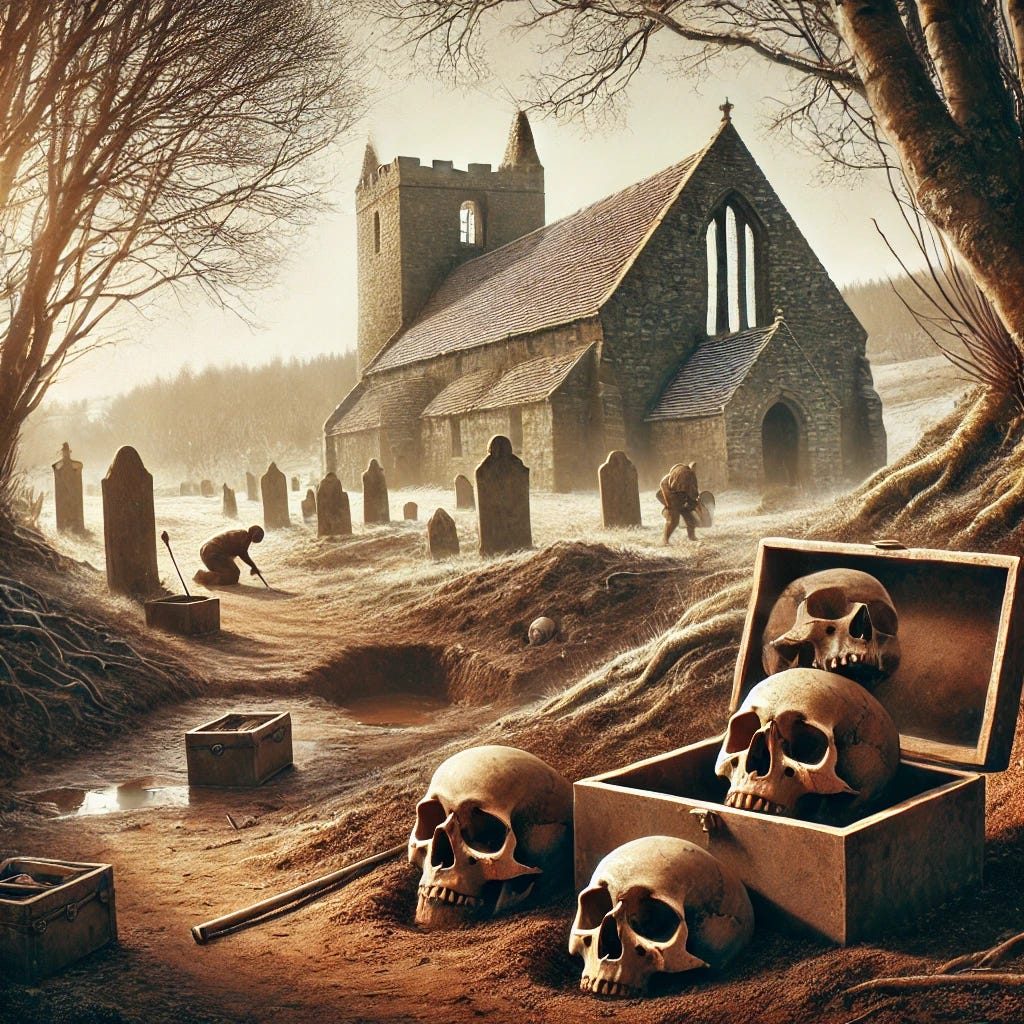The Puzzle of Skulls Enclosed in Stone Boxes
In the late 18th century, workers excavating near the ruins of St. Fink Chapel in Bendochy made a startling discovery—human skulls encased in carefully constructed stone boxes. These skeletal remains, meticulously separated from their bodies and seemingly preserved with intent, have intrigued historians and archaeologists for generations. The precise reasons for such an unusual burial practice remain unknown, but the find raises fascinating questions about the beliefs, rituals, and circumstances of the people who lived in this area centuries ago. Were these burials part of a ritualistic tradition, a response to practical needs, or evidence of ancient superstitions? This blog post delves into the context of these enigmatic skulls, exploring the potential meanings behind their burial and their significance in Scotland’s history.
The Discovery of the Stone-Enclosed Skulls
The skulls were unearthed during an excavation near St. Fink Chapel, a site of historical and spiritual importance in the parish of Bendochy. As the workers cleared the soil, they found several skulls encased within stone boxes, their precise construction suggesting a deliberate and thoughtful burial process. Unlike traditional graves, the remains consisted only of skulls, with no accompanying bodies or grave goods.
The date of the skulls’ burial is still uncertain, but their condition and placement indicate a ritual or purposeful interment rather than accidental deposition. Some of the skulls bore signs of trauma, hinting at violent deaths, possibly in battle. The variation in craftsmanship among the stone casings suggests that these individuals may have come from different social classes or time periods.
Theories Behind the Stone-Cased Skulls
The unusual nature of these burials has prompted various interpretations over the years, drawing on historical, cultural, and practical explanations.
1. Ritualistic or Ceremonial Significance
One prominent theory posits that the skulls had a ceremonial or ritualistic purpose. In ancient Celtic and Pictish traditions, the head was often regarded as the seat of the soul and a source of power. By isolating and preserving skulls in stone, the community may have sought to honor their dead or ensure the spiritual protection of the remains.
The effort invested in creating these stone enclosures could signify the importance of the deceased individuals or their connection to the community. The absence of grave goods might further suggest a focus on the spiritual essence of the person, rather than their material possessions.
2. War Memorials or Trophies
Given the signs of trauma found on some of the skulls, it is possible that they belonged to warriors who died in combat. Encasing the skulls in stone may have been a way to honor their bravery or preserve their memory for future generations. Alternatively, these skulls could represent trophies taken from enemies during a battle, signifying victory or dominance.
The Picts, known for their fierce resistance to Roman and later Anglo-Saxon invasions, may have used this practice to commemorate significant conflicts or victories.
3. Practical Responses to Disease
A more utilitarian explanation is that these stone boxes were created to contain the remains of individuals who succumbed to a contagious disease. In times of plague or pestilence, burial practices often adapted to mitigate the risk of spreading infection. Encasing skulls in stone could have been a protective measure, isolating the remains and reducing the chances of contamination.
If further archaeological evidence from the surrounding area supports this theory—such as mass graves or signs of epidemics—it could provide critical insight into how early communities responded to public health crises.
4. Spiritual Safeguarding Against Restless Spirits
Another theory draws upon local folklore and ancient superstitions. Many medieval communities believed that the dead could rise or that their spirits could haunt the living. Encasing skulls in stone might have been a form of spiritual containment, ensuring that these spirits were kept at peace and could not interfere with the living.
The proximity of the skulls to St. Fink Chapel, a sacred Christian site, suggests that these burial practices may have been influenced by both pre-Christian and Christian beliefs, blending old customs with newer religious traditions.
Parallels in Ancient Burial Practices
The discovery of stone-encased skulls is not unique to Bendochy. Similar burial practices have been uncovered elsewhere in Scotland and across Europe, offering valuable comparative insights:
Pictish Burial Traditions: The Picts, who once inhabited the region, were known for their distinct burial customs, often incorporating stone markers or enclosures. The use of stone in these burials may have symbolized protection or permanence.
Neolithic Cairns and Burial Chambers: Throughout Scotland, cairns and stone-built tombs have been used for centuries to house the dead. Although these structures typically included whole bodies, the emphasis on stone suggests a cultural reverence for the material.
Skull Cults in Europe: In several parts of Europe, archaeological evidence points to the ritual curation of skulls, sometimes as symbols of power or ancestor veneration. The stone-encased skulls of Bendochy could represent a localized adaptation of this practice.
Unanswered Questions and Future Research
Despite numerous theories, the true meaning behind the stone-encased skulls remains elusive. Advances in archaeological technology, such as carbon dating and isotopic analysis, may help to narrow down their time period and provide clues about the individuals' origins and lives. DNA analysis could reveal familial connections or migration patterns, further enriching our understanding of Bendochy’s past.
Additionally, further excavation of the area around St. Fink Chapel may uncover more remains or artifacts that could shed light on the cultural and historical context of these burials.
A Testament to Human Complexity
The skulls encased in stone boxes at St. Fink Chapel remain one of the most intriguing archaeological puzzles in Bendochy. Whether they reflect ancient rituals, practical measures, or a combination of both, they stand as a testament to the complexity of human societies and their attempts to understand life and death. These enigmatic burials connect us to a past rich in tradition, belief, and innovation, offering a fascinating glimpse into the lives of those who came before us.





